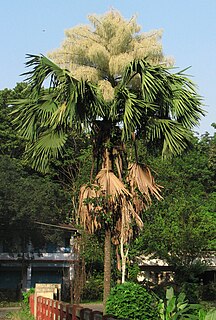
The International Union for Conservation of Nature (IUCN) Red List of Threatened Species, founded in 1964, is the world's most comprehensive inventory of the global conservation status of biological species. It uses a set of precise criteria to evaluate the extinction risk of thousands of species and subspecies. These criteria are relevant to all species and all regions of the world. With its strong scientific base, the IUCN Red List is recognized as the most authoritative guide to the status of biological diversity. A series of Regional Red Lists are produced by countries or organizations, which assess the risk of extinction to species within a political management unit.

Corypha is a genus of palms, native to India, Malaysia, Indonesia, the Philippines, New Guinea and northeastern Australia. They are fan palms, and the leaves have a long petiole terminating in a rounded fan of numerous leaflets.

Corypha umbraculifera, the talipot palm, is a species of palm native to eastern and southern India and Sri Lanka. It is also grown in Cambodia, Myanmar, China, Thailand and the Andaman Islands. It is a flowering plant with the largest inflorescence in the world. It lives up to 60 years before bearing flowers and fruits. It dies shortly after.

A near-threatened species is a species which has been categorized as "Near Threatened" (NT) by the International Union for Conservation of Nature as that may be vulnerable to endangerment in the near future, but it does not currently qualify for the threatened status.

The horned guan is a large, approximately 85 cm (33 in) long, turkey-like bird with glossy black dorsal plumage, red legs, a white iris, a yellow bill, and a red horn on top of its head. The breast and upper belly are white, and its long tail feathers are black with a white band near the base. Both sexes are similar. The young are duller with a smaller horn, and have a brown tail and wings.

Corypha taliera is a species of palm, originally native to Myanmar (Burma) and the Bengal region of India and Bangladesh. It was first discovered by Scottish botanist William Roxburgh. It has been listed extinct in the wild in the IUCN Red list. The species is locally known as Tali Palm or Talipalm.

A species that is extinct in the wild (EW) is one that has been categorized by the International Union for Conservation of Nature as known only by living members kept in captivity or as a naturalized population outside its historic range due to massive habitat loss.
This article is a list of biological species, subspecies, and evolutionary significant units that are known to have become extinct during the Holocene, the current geologic epoch, ordered by their known or approximate date of disappearance from oldest to most recent.

Tasmanipatus anophthalmus, the blind velvet worm, is a species of velvet worm in the family Peripatopsidae. The species is listed as Endangered on the IUCN Red List.

The Bulgarian emerald, Corduliochlora borisi, is a species of dragonfly in the family Corduliidae, and the only species in the genus Corduliochlora. It is found in Bulgaria, Greece, and Turkey. Its natural habitat is rivers. It is threatened by habitat loss. The species is named after Boris Marinov. It was formerly treated as a member of the genus Somatochlora.
Bat Conservation International (BCI) is an international nongovernmental organization working to conserve bats and their habitats through conservation, education, and research efforts.

The World's 25 Most Endangered Primates is a list of highly endangered primate species selected and published by the International Union for Conservation of Nature (IUCN) Species Survival Commission (SSC) Primate Specialist Group (PSG), the International Primatological Society (IPS), Global Wildlife Conservation (GWC), and Bristol Zoological Society (BZS). The IUCN/SSC PSG worked with Conservation International (CI) to start the list in 2000, but in 2002, during the 19th Congress of the International Primatological Society, primatologists reviewed and debated the list, resulting in the 2002–2004 revision and the endorsement of the IPS. The publication was a joint project between the three conservation organizations until the 2012–2014 list when BZS was added as a publisher. The 2018–2020 list was the first time Conservation International was not among the publishers, replaced instead by GWC. The list has been revised every two years following the biannual Congress of the IPS. Starting with the 2004–2006 report, the title changed to "Primates in Peril: The World's 25 Most Endangered Primates". That same year, the list began to provide information about each species, including their conservation status and the threats they face in the wild. The species text is written in collaboration with experts from the field, with 60 people contributing to the 2006–2008 report and 85 people contributing to the 2008–2010 report. The 2004–2006 and 2006–2008 reports were published in the IUCN/SSC PSG journal Primate Conservation,, since then they have been published as independent publications.









